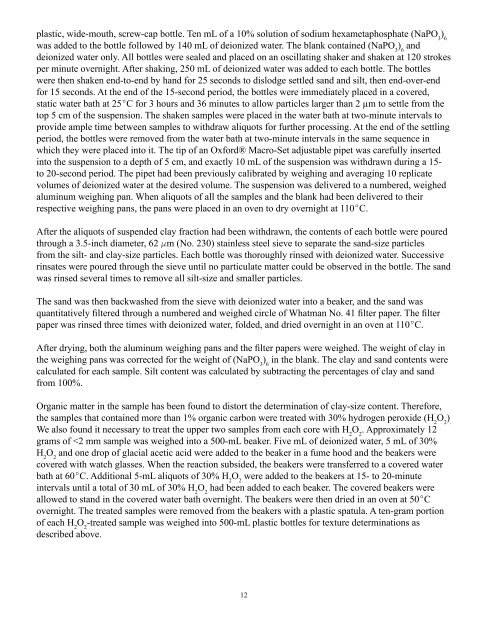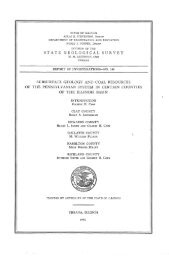Cores 11 through 26 by Gary B. Dr - University of Illinois at Urbana ...
Cores 11 through 26 by Gary B. Dr - University of Illinois at Urbana ...
Cores 11 through 26 by Gary B. Dr - University of Illinois at Urbana ...
You also want an ePaper? Increase the reach of your titles
YUMPU automatically turns print PDFs into web optimized ePapers that Google loves.
plastic, wide-mouth, screw-cap bottle. Ten mL <strong>of</strong> a 10% solution <strong>of</strong> sodium hexametaphosph<strong>at</strong>e (NaPO 3) 6was added to the bottle followed <strong>by</strong> 140 mL <strong>of</strong> deionized w<strong>at</strong>er. The blank contained (NaPO 3) 6anddeionized w<strong>at</strong>er only. All bottles were sealed and placed on an oscill<strong>at</strong>ing shaker and shaken <strong>at</strong> 120 strokesper minute overnight. After shaking, 250 mL <strong>of</strong> deionized w<strong>at</strong>er was added to each bottle. The bottleswere then shaken end-to-end <strong>by</strong> hand for 25 seconds to dislodge settled sand and silt, then end-over-endfor 15 seconds. At the end <strong>of</strong> the 15-second period, the bottles were immedi<strong>at</strong>ely placed in a covered,st<strong>at</strong>ic w<strong>at</strong>er b<strong>at</strong>h <strong>at</strong> 25C for 3 hours and 36 minutes to allow particles larger than 2 µm to settle from thetop 5 cm <strong>of</strong> the suspension. The shaken samples were placed in the w<strong>at</strong>er b<strong>at</strong>h <strong>at</strong> two-minute intervals toprovide ample time between samples to withdraw aliquots for further processing. At the end <strong>of</strong> the settlingperiod, the bottles were removed from the w<strong>at</strong>er b<strong>at</strong>h <strong>at</strong> two-minute intervals in the same sequence inwhich they were placed into it. The tip <strong>of</strong> an Oxford® Macro-Set adjustable pipet was carefully insertedinto the suspension to a depth <strong>of</strong> 5 cm, and exactly 10 mL <strong>of</strong> the suspension was withdrawn during a 15-to 20-second period. The pipet had been previously calibr<strong>at</strong>ed <strong>by</strong> weighing and averaging 10 replic<strong>at</strong>evolumes <strong>of</strong> deionized w<strong>at</strong>er <strong>at</strong> the desired volume. The suspension was delivered to a numbered, weighedaluminum weighing pan. When aliquots <strong>of</strong> all the samples and the blank had been delivered to theirrespective weighing pans, the pans were placed in an oven to dry overnight <strong>at</strong> <strong>11</strong>0C.After the aliquots <strong>of</strong> suspended clay fraction had been withdrawn, the contents <strong>of</strong> each bottle were poured<strong>through</strong> a 3.5-inch diameter, 62 m (No. 230) stainless steel sieve to separ<strong>at</strong>e the sand-size particlesfrom the silt- and clay-size particles. Each bottle was thoroughly rinsed with deionized w<strong>at</strong>er. Successiverins<strong>at</strong>es were poured <strong>through</strong> the sieve until no particul<strong>at</strong>e m<strong>at</strong>ter could be observed in the bottle. The sandwas rinsed several times to remove all silt-size and smaller particles.The sand was then backwashed from the sieve with deionized w<strong>at</strong>er into a beaker, and the sand wasquantit<strong>at</strong>ively filtered <strong>through</strong> a numbered and weighed circle <strong>of</strong> Wh<strong>at</strong>man No. 41 filter paper. The filterpaper was rinsed three times with deionized w<strong>at</strong>er, folded, and dried overnight in an oven <strong>at</strong> <strong>11</strong>0C.After drying, both the aluminum weighing pans and the filter papers were weighed. The weight <strong>of</strong> clay inthe weighing pans was corrected for the weight <strong>of</strong> (NaPO 3) 6in the blank. The clay and sand contents werecalcul<strong>at</strong>ed for each sample. Silt content was calcul<strong>at</strong>ed <strong>by</strong> subtracting the percentages <strong>of</strong> clay and sandfrom 100%.Organic m<strong>at</strong>ter in the sample has been found to distort the determin<strong>at</strong>ion <strong>of</strong> clay-size content. Therefore,the samples th<strong>at</strong> contained more than 1% organic carbon were tre<strong>at</strong>ed with 30% hydrogen peroxide (H 2O 2) .We also found it necessary to tre<strong>at</strong> the upper two samples from each core with H 2O 2. Approxim<strong>at</strong>ely 12grams <strong>of</strong>
















